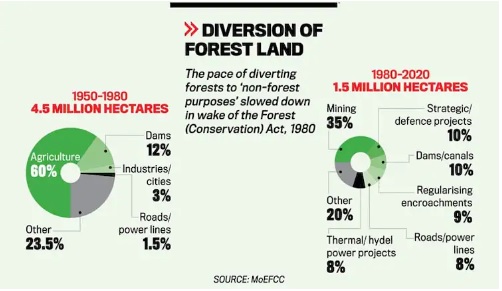Community Rights and Forest Conservation | 14 Nov 2023
This editorial is based on “Community rights and forest conservation “ which was published in The Hindu on 13/11/2023. It talks about the Forest (Conservation) Amendment Act of 2023, emphasizing its goals, related challenges, and the consequences it poses for the indigenous residents of the forests.
For Prelims: Forest (Conservation) Amendment Act 2023, Net Zero Emission , Nationally Determined Contribution (NDC), Forest Act,1927, Line of Actual Control (LAC), Line of Control (LoC), Compensatory Afforestation, EIA.
For Mains: Key Provisions of the Forest (Conservation) Amendment Act, Benefits of the Forest Conservation Amendment Act, Key Issues with the Amendment, Way Forward for Better Implementation of the Act.
The recently passed Forest (Conservation) Amendment Act, 2023 brings substantial legislative changes to the Forest (Conservation) Act of 1980, a crucial environmental law in India governing forest conservation. However, it has received limited attention and little discussion about its impact on forests and their inhabitants.
What are the Key Provisions of the Amendment?
- Insertion of Preamble:
- The Amendment Act introduces a Preamble to the Forest (Conservation) Act.
- This Preamble officially acknowledges India's commitment to achieving Net Zero Emission by 2070, meeting the Nationally Determined Contribution (NDC) targets by 2030, and expanding India's forest and tree cover to one-third of its land area.
- Land under the Purview of the Act:
- As per the amendment, the forest law will now apply exclusively to areas categorized under the Forest Act,1927 and those designated as such on or after October 25, 1980. The Act will not be applicable to forests that were converted for non-forest use on or after December 12, 1996.
- The amendments seek to streamline the application of the Act to recorded forest lands, private forest lands, plantations, etc.
- Exempted Categories of Land:
- The Bill proposes certain exemptions to encourage afforestation and plantation outside forests.
- For instance, 0.10 ha of forest land has been proposed to provide connectivity for habitation and establishments located on the side of roads and railways, up to 10 ha of land proposed for security-related infrastructure, and up to 5 ha of forest land in Left Wing Extremism Affected Districts for public utility projects.
- These exemptions include strategic projects related to national security within 100 km of the International Borders, Line of Actual Control (LAC), Line of Control (LoC), etc.
- Leasing of Forest Land:
- Under the Act, a state government requires prior approval of the central government to assign forest land to any entity not owned or controlled by the government.
- Under the Act, this condition is extended to all entities, including those owned and controlled by the government. It also requires that prior approval be subject to terms and conditions prescribed by the central government.
- Permitted Activities in Forest Land:
- The Act restricts the de-reservation of forests or the use of forest land for non-forest purposes. Such restrictions may be lifted with the prior approval of the central government.
- The Act specifies certain activities that will be excluded from non-forest purposes, meaning that restrictions on the use of forest land for non-forest purposes will not apply.
- These activities include works related to the conservation, management, and development of forests and wildlife such as establishing check posts, fire lines, fencing, and wireless communication.
- Expansion of the Central Government’s Power of Delegated Legislation:
- Prior to the amendment, the power of the Central Government to make delegated legislation was limited to making Rules only.
- In order to ensure proper implementation of the provisions of the Act, the delegated legislation-making power of the Central Government has been expanded and it is now been bestowed with the power to issue “directions” to any central government authority, State Governments, Union territories, or to any organization, entity or body recognized by them.
What are the Benefits of the Forest Conservation Amendment Act, 2023?
- Clarity on the Definition of 'Forest':
- The Amendment clarifies the definition of Forest which addresses ambiguity around "deemed forests" and diverse interpretations.
- The Amendment clarifies FCA application to notified and recorded forests only, resolving ambiguity.
- Exemptions, already in practice, now have statutory backing, providing clarity for public utilities, national security projects, and citizen interests.
- Climate Change Mitigation and Conservation:
- It aims to achieve the country’s national as well as international commitments of NDCs, and carbon neutrality, eliminate the ambiguities, and bring clarity about the applicability of the Act in various lands, promoting the plantation in non-forest land, enhancing the productivity of the forests.
- Provisions for Development:
- The amendment is contextualized within the historical backdrop of the Godavarman Thirumulkpad case and opposition from private landowners, organizations, and individuals who argue that forest conservation laws hinder industrial progress.
- This act will facilitate economic exploitation by removing certain forest areas from legal jurisdiction, allowing for diverse uses, including linear projects and security infrastructure.
- National Security:
- The Act exempts certain linear infrastructure projects, such as roads and highways, from seeking forest clearance permissions if they are located within 100 km of the national border.
- This is expected to facilitate the development of infrastructure in border areas, which is important for national security.
- Compensatory Afforestation:
- The amendment promotes compensatory afforestation, allowing private entities to undertake afforestation or reforestation projects.
- Empowering Local Communities:
- The Bill encourages activities like the establishment of zoos, safaris, and ecotourism, which will be owned by the government and set up in approved plans outside Protected Areas.
- These activities not only raise awareness about forest conservation and wildlife protection but also create livelihood opportunities for local communities, integrating them with the overall development
What are the Key Issues with the Amendment?
- Redefining Forests:
- The Act created a contradiction to the pre-existing definition of forest defined by the Supreme Court of India in a 1996 order, stating any patches of trees recorded as forest in any government records, irrespective of ownership, recognition, and classification, would automatically become a deemed forest.
- Approximately one-fifth to one-fourth of India’s forests have lost their legal safeguard due to the modification of the definition under this amendment in the existing Act, according to the Punjab-based Public Action Committee (PAC).
- Infrastructure Encroachment:
- Exempting land near border areas for national security projects may adversely impact the forest cover and wildlife in northeastern states.
- A blanket exemption for projects like zoos, eco-tourism facilities, and reconnaissance surveys may adversely affect forest land and wildlife
- Neglect of Tribal Rights:
- The amendment removes the requirement for prior consent from tribal grama sabhas for alterations to forests for non-forest purposes.
- Permission for private companies to use forest land for ecotourism may promote corporate interests at the expense of tribal communities' livelihoods.
- Potential negative impacts on local cultures and traditions due to mass tourism.
- Top-Down Authority:
- The amendments raised concerns about potential forest exploitation by private, profit-driven companies or firms and neglection of state governments’ concerns by consolidating more power in the hands of the central government.
- Human-Animal Conflicts:
- Man-animal conflicts will increase if infrastructure development is allowed on forest land
- The amendment does not address growing human-animal conflicts in tribal hamlets, posing threats to both livelihoods and wildlife.
What Should be The Way Forward?
- Stakeholder Consultation:
- Engage in extensive consultations with environmental experts, tribal communities, local stakeholders, and NGOs to address concerns and incorporate diverse perspectives.
- Emphasis on inclusiveness, local participation, and transparency in decision-making.
- Transparency in Decision-Making:
- Ensure transparency in the decision-making process related to forest land use, exemptions, and infrastructure projects, fostering trust among stakeholders.
- Periodic Review Mechanism:
- Establish a robust periodic review mechanism to assess the impact of the Act on forests, biodiversity, and local communities, making necessary adjustments based on the findings.
- Consider amendments to the Act based on feedback and evolving circumstances, ensuring inclusivity and responsiveness to emerging environmental challenges.
- Empowerment of Local Communities:
- Empower local communities, especially tribal groups, by involving them in decision-making processes, recognizing their traditional knowledge, and ensuring equitable benefits from forest resources.
- Reinforce legal safeguards to protect the rights of indigenous communities, acknowledging their historical connection to forest lands and ensuring their participation in conservation efforts.
- Environmental Impact Assessment (EIA):
- Strengthen the EIA process to comprehensively assess the environmental impact of proposed projects, ensuring sustainable development while minimizing ecological damage.
- Conflict Resolution Mechanisms:
- Establish efficient conflict resolution mechanisms to address disputes arising from the Act, providing a fair platform for all stakeholders to voice concerns and seek resolution.
- Invest in capacity building for relevant authorities, ensuring effective implementation of the Act, adherence to guidelines, and competent decision-making.
- Scientific Research and Monitoring:
- Promote scientific research to monitor the impact of the Act on forest ecosystems, biodiversity, and climate goals, using data-driven insights for informed policy adjustments.
- Develop adaptive management strategies that allow for flexibility in responding to unforeseen challenges and evolving environmental conditions.
Conclusion:
The path to national development should be a collective expedition, marked by a commitment to environmental sustainability that steadfastly guides the pursuit of progress. The Forest Conservation Act serves as evidence of the potential to strike this intricate balance, paving the way for a future where a prosperous nation seamlessly coexists with a thriving environment.
|
Dristi Mains Question: Discuss the advantages and significant challenges associated with the Forest (Conservation) Amendment Act, 2023. How can this amendment play a pivotal role in steering a course where development and environmental sustainability can actively support each other toward national progress? |
UPSC Civil Services Examination, Previous Year Question (PYQ)
Prelims:
Q. Consider the following statements: (2019)
1. As per a recent amendment to the Indian Forest Act, of 1927, forest dwellers have the right to fell the bamboo grown in forest areas.
2. As per the Scheduled Tribes and Other Traditional Forest Dwellers (Recognition of Forest Rights) Act, 2006, bamboo is a minor forest produce.
3. The Scheduled Tribes and Other Traditional Forest Dwellers (Recognition of Forest Rights) Act, 2006 allows ownership of minor forest produce to forest dwellers.
Which of the statements given above is/are correct?
(a) 1 and 2 only
(b) 2 and 3 only
(c) 3 only
(d) 1, 2 and 3
Ans: (b)
Mains:
Q.“Policy contradictions among various competing sectors and stakeholders have resulted in inadequate ‘protection and prevention of degradation’ to the environment.” Comment with relevant illustrations. (2018)


